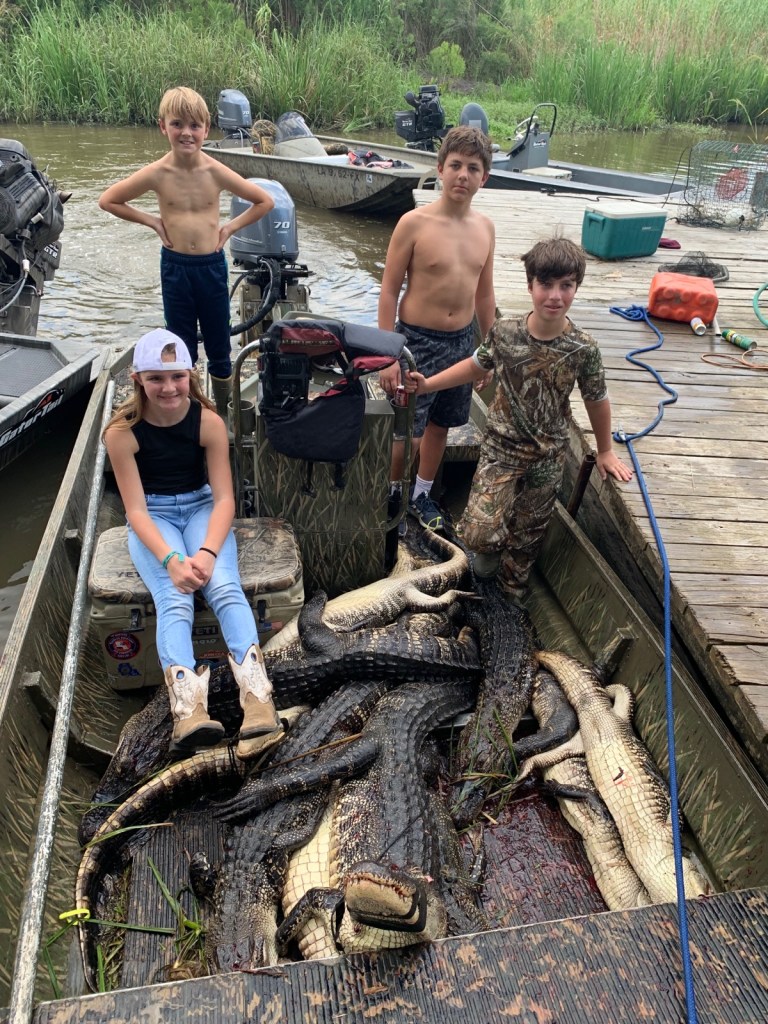Second day of special teal season a charm for Elias brothers in marsh
Published 1:00 am Sunday, September 18, 2022

- An alligator hunt during opener weekend of the 2022 special teal season in Louisiana resulted in a boatload of alligators around Onion Lake near Intracoastal City in Vermilion Parish. Enjoying the alligator hunt as much as the teal shooting were, from upper left, clockwise, Charlie Stelly, E.J. Broussard, Jacque Stelly and Olivia Stelly.
Ninety-seven percent of the estimated 264,000 blue-winged teal down for opening weekend of the special teal season in the state were in southwest Louisiana.
Someone would have had a hard time convincing Dr. Eric Elias’ duck hunting group of that early on opening day Sept. 10. They were in three duck blinds that Saturday morning on the family’s lease in the marsh around Onion Lake near Intracoastal City.
Elias’ duck blind, which concealed him, his father, Dr. Darryl Elias Sr. of New Iberia, his brother, Dr. Darryl Elias Jr. of Lafayette, formerly of New Iberia, his two nephews, Sawyer Elias and Parker Elias, and Jed Inzerella of New Iberia, accounted for seven of the nine teal that went back to the camp.
“We killed everything that came by. We just didn’t see a whole lot of life,” Dr. Eric Elias said a few days later. “Teal hunting Saturday morning was very slow. We had one blind that did not shoot any.”
“Sunday was a different story. I went hunting with my brother. We probably saw several thousand blue-winged teal fly over. Most of the birds we saw were going east to west,” he said, noting those ducks probably originated from the western edge of Vermilion Bay.
The Eliases’ duck hunting success improved dramatically. It was an excellent adventure that second day.
Waterfowlers both days saw beaucoup Mexican squealers and even more wood ducks, he said. The former has a unique noise and unique flight pattern, he added, at the same time wishing it was legal to hunt the species.
The ducks are common in Louisiana and Texas, which is the primary breeding area for the birds.
However, the focus is on blue-winged teal until the special season ends Sept. 25. It’s a time when insect repellent is a must and it’s a time for wearing light shirts.
It’s a warmup for the regular waterfowl hunting season that opens Nov. 12 in the West Zone and Nov. 19 in the East Zone.
“It’s the best time of the year, getting back in the marsh, finding out what needs to be fixed. It’s definitely a good time of the year. Cajun Dream. We live it,” Dr. Eric Elias said.
After Saturday’s duck hunt, Dr. Marcus Stelly and Gordy Broussard joined him in filling out 11 alligator tags with 6- to 7-foot long ‘gators. They connected with chickens hanging from set lines, according to Dr. Eric Elias, while his brother took some of the youngsters fishing and caught redfish and flounder on Berkley Gulp!
The 44-year obstetrician who practices in Breaux Bridge planned to skip this weekend but return to the lease for more teal hunting on the last weekend of the special season Sept. 24-25.
The week before the special teal opened, Louisiana’s waterfowl program manager, a staffer and pilot conducted an aerial waterfowl popular survey across coastal Louisiana and Catahoula Lake.
Jason Olszak, in his second year as the state’s waterfowl study leader after replacing veteran waterfowl biologist Larry Reynolds, reported there were an estimated 264,000 blue-winged teal in the state, 257,000 of them in southwest Louisiana.
The overall number of teal was down 6 percent from September 2021, Olszak wrote in a prepared statement released Sept 9. However, it was 37 percent higher than the most recent five-year average and 44 percent higher than the most recent 10-year average.
This region’s teal numbers were up 23 percent over 2021.
Southwest Louisiana’s habitat conditions are above average entering the second week of teal hunting-only, according to Olszak. Dry conditions prevalent during spring and early summer gave way to normal water levels.
There are many areas of what he called “excellent” submerged aquatic vegetation growth, particularly west of Calcasieu Lake and surrounding Vermilion Bay.
Olszak pointed out that a recent USDA National Agricultural Statistics Survey indicated 75 percent of rice crop has been harvested statewide and the overall amount of water on the landscape in this region was improved over last winter. Also, he noted, most harvested or second crop rice fields had shallow water, a clear amount of fields were rolled/buffaloed with shallow water and very few fields were drained and worked.
The waterfowl program manager said the majority of teal in southwest Louisiana were in fallow or post-harvest, agricultural fields east and west of Gueydan. Lower numbers were seen in agricultural fields west of Bell City, north of Intracoastal City and in the marsh of the Sabine National Wildlife Refuge.
Southeast Louisiana’s teal population estimate of 7,000 was 89 percent lower than at this time last year. No teal were counted on Catahoula Lake compared to 6,000 in September 2021.





